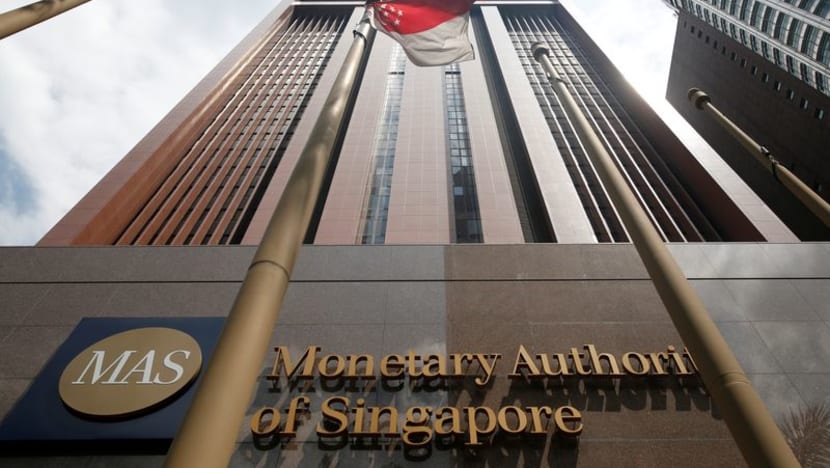MAS keeps monetary policy unchanged for third time in a row
The Monetary Authority of Singapore says it will closely monitor global and domestic economic developments, while remaining vigilant to inflation and growth risks.

A view of the Monetary Authority of Singapore's headquarters in Singapore June 28, 2017. (FILE PHOTO: REUTERS/Darren Whiteside)

This audio is generated by an AI tool.
SINGAPORE: The Monetary Authority of Singapore (MAS) kept its exchange rate-based monetary policy unchanged on Monday (Jan 29), standing pat for the third consecutive meeting and in line with market expectations.
In its monetary policy statement, the Singapore central bank said it will “maintain the prevailing rate of appreciation” of its Singapore dollar nominal effective exchange rate (S$NEER) policy band.
There are no changes to the width of the policy band and the level at which it is centred.
All 13 analysts polled by Reuters had expected MAS to hold off making changes to its policy in this scheduled review.
Monetary policy had been left unchanged at the two policy reviews in 2023, with the last adjustment – a re-centering of the mid-point of its policy band – in October 2022.
Unlike most central banks that manage monetary policy through the interest rate, MAS manages monetary policy by letting the local dollar rise or fall against the currencies of its main trading partners within an undisclosed band, known as the S$NEER.
It adjusts its policy by changing the slope, mid-point and width of the policy band.
ECONOMIC AND INFLATION OUTLOOK
Laying out its outlook ahead, MAS noted that prospects for the Singapore economy should continue to improve in the year ahead, with gross domestic product (GDP) growth projected to come in between 1 and 3 per cent.
A turnaround in the global electronics cycle and anticipated easing in global interest rates should help to support a recovery in the manufacturing and financial sectors, as growth in the domestic-oriented sectors normalise further towards pre-pandemic rates.
“Barring any further global shocks, the Singapore economy is expected to strengthen in 2024, with growth becoming more broad-based,” it wrote in its policy review statement.
Turning to inflation, the central bank expects core inflation, which excludes the costs of accommodation and private transport, to likely remain elevated in the earlier part of the year.
For the first quarter, a rise in consumer prices is to be expected partly due to a “one-off” impact from the 1-percentage-point increase in the Goods and Services Tax (GST), as well as the hike in carbon tax.
In the second quarter, water prices will go up – by 20 cents per cubic metre from Apr 1 – as part of a phased increase to cope with higher production costs.
Elsewhere, inflation for certain services components, including public transport and healthcare, could also “stay elevated as less frequently-adjusted prices rise to catch up with higher cost levels”, MAS said.
But core inflation, which is a key barometer for the central bank, should decline gradually and step down by the fourth quarter before falling further next year, MAS added.
The key inflation gauge is expected to slow to an average of 2.5 to 3.5 per cent for 2024, unchanged from earlier estimates. Excluding the impact of the increase in the GST rate this year, core inflation is forecast at 1.5 to 2.5 per cent.
“Accordingly, current monetary policy settings remain appropriate,” MAS wrote in its statement.
“The sustained appreciation of the policy band will continue to dampen imported inflation and curb domestic cost pressures, thus ensuring medium-term price stability.”
However, the central bank lowered its estimates for overall inflation to a range of 2.5 to 3.5 per cent, down from the previous range of 3 to 4 per cent. This is due to declines in the certificate of entitlement (COE) premiums since November and the larger COE supply this year compared to 2023.
Excluding the effects of the increase in the GST rate, headline inflation is forecast at 1.5 to 2.5 per cent.
MAS noted that both upside and downside risks to the inflation outlook remain.
“Shocks to global food and energy prices or domestic labour costs could bring about additional inflationary pressures. However, an unexpected weakening in the global economy could induce a faster easing of cost and price pressures,” it said.
MAS added that it will closely monitor global and domestic economic developments, while remaining vigilant to inflation and growth risks.
At least two economists reckoned that MAS will keep policy settings unchanged for some time, given concerns about sticky inflation amid external geopolitical uncertainties and domestic price hikes.
“As alluded to by the MAS, ‘both upside and downside risks to the inflation outlook remain’, which is to say an unconditional shift to neutral stance that drops all hawkish refrains is unlikely in the near term,” a note from Mizuho Bank said.
ING’s senior economist Nicholas Mapa echoed that.
“Given the inflation outlook is still elevated but moderating, and with MAS opting to pause today due to concerns about the inflation path, we expect the MAS to be on hold for at least another meeting,” he said.
“However, should inflation moderate towards the second half of the year as forecast, the MAS could consider adjusting policy settings at their third or fourth meeting of the year.”
This is the first time MAS is making a scheduled monetary policy statement in January, following an announcement last year that it would shift to a quarterly schedule, from semi-annual, in 2024.
As part of the change, monetary policy will be reviewed in January, April, July and October, instead of just April and October.
Economists have said that the increased frequency in policy reviews was likely spurred by a need to remain nimble in an increasingly uncertain world.

















